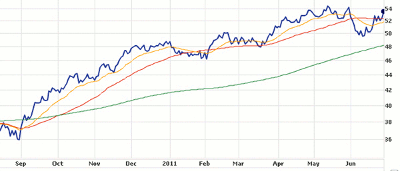Also to bed frames, and sheets and towels, and new and used cars—and yes, even into stocks, writes MoneyShow.com senior editor Igor Greenwald.
Things are not going according to the script distributed by all the horror-movie fans out there.
Spooked by the ugly unemployment numbers and the horrendous housing mess, the S&P 500 should have crushed hope once and for all by now, by slicing through its 200-day average like a large knife through the shower curtain.
The Greeks were supposed to break up Europe, with aggrieved depositors lined up outside shuttered banks.
Emerging markets should have collapsed under the crushing burden of rate hikes, exposing claims of rapid progress in recent years as a cruel illusion. Meanwhile, the US economy, until recently doomed to hyperinflation, was to have fallen into another deflationary spiral instead, as losses in the stock and housing markets claimed more jobs.
By now, profit warnings should have been pouring in. Instead, results and forecasts from FedEx (FDX), Oracle (ORCL), Nike (NKE), and even Bed Bath & Beyond (BBBY) suggest that business has never been better.
I’m not going to claim that some of those fears won’t come true one day—they very well might, in due time. Bit I’m going to go out on a limb, and argue that the market’s biggest two-day rally in five months hints that all these bad things won’t happen in rapid succession one day soon, plunging the world into an economic nightmare.
It’s pretty hard to hurt oneself while falling from one’s knees, which is the posture the US economy held before its recent stumble.
For example, consumers have already adjusted to high unemployment by boosting their savings rate to 5%, yet the cars virtually given away by Detroit in 2003 and 2004 are really showing their age, which may be why so many automotive stocks are taking off (if not yet those of the domestic manufacturers).
Industrial capacity utilization is stuck below 77%, and no one has been ordering big inventories that would need to be worked off if things keep slowing down.
Economic downturns require a certain level of initial optimism to burn off, to build some downward momentum. They seldom take root amid serious economic slack, pervasive cynicism, and negative real interest rates.
Does this look like a sickly chart?
That’s the SPDR S&P Retail Index (XRT), bouncing back toward May highs. Select Comfort (SCSS) and Tempurpedic (TPX) are already there after posting 20%-plus sales growth.
How can so many suppliers of big-ticket items, from the auto dealers to the sellers of fancy beds, be doing so well if the economy is really about to give up the ghost? Haven’t they heard that consumer confidence recently fell? Why haven’t they been hurt by the glut of unsold homes?
Wall Street greeted this week’s rally with a massive yawn, because:
- the charts still suggest stocks could relapse at any moment;
- and the relief arrived at the quarter’s end, when a bullish bias often prevails, as managers window dress their portfolios.
This is exactly the sort of healthy skepticism one would expect at a significant market low. The Options Volatility Index (VIX) is stuck above 19.
Caveats and reasons for caution are a dime a dozen. But the action in some of the most economically sensitive consumer stocks is telling a different story, one that deserves the benefit of the doubt.






















